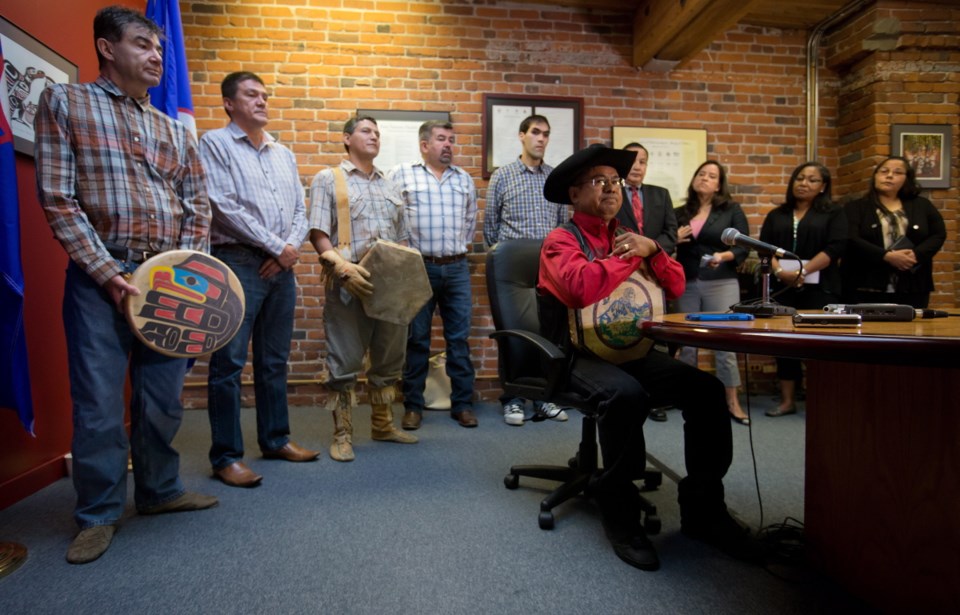 Pat Vickers’ daughter phoned her at 6:30 Thursday morning and told her to turn on the TV. She did, and they both started crying.
Pat Vickers’ daughter phoned her at 6:30 Thursday morning and told her to turn on the TV. She did, and they both started crying.
They were watching the beginning of hours of coverage of the Supreme Court of Canada decision on what the words “aboriginal title” mean. It had special resonance for them, because it was clear from the start that the judgment amounts to a vindication for Vickers’ late husband, David.
He was the B.C. Supreme Court judge who immersed himself in the Tsilhqot’in Nation’s claim for ownership of a remote chunk of Chilcotin wilderness. (It’s wilderness because about 100 native people blocked the loggers more than 20 years ago, which started the case.)
After delving exhaustively into every aspect of the aboriginal existence and history in the region, he decided the Tsilhqot’in had proven rights to much of the Nemiah Valley and those rights were being violated by government logging plans. The decision stopped short of granting title outright because of a technicality relating to the “all or nothing” approach from the plaintiffs. But his 458-page judgment in 2007 joined the list of momentous aboriginal title decisions. It was appealed for various reasons and five years later the B.C. Court of Appeals scaled back the import of the ruling.
The case progressed from there to the Supreme Court of Canada last winter. Thursday’s decision was the word from on high about the case. And the word is mostly a broad endorsement of Vickers’ interpretation of the case.
“The trial judge was correct,” the high court said. “Absent demonstrated error, his findings should not be disturbed.”
It was good news for First Nations, but they were also sweet words for the Vickers family to hear.
“We are just over the moon,” Pat Vickers said. “Delighted.”
She recalled the phenomenal amount of work he put into the case. It arrived in his Victoria courtroom in 2002 and proceeded over 339 days during the next five years. It cost a staggering amount of money, at least $30 million, all of it funded by governments. Vickers moved proceedings up to the Chilcotin for several weeks early on to get a feel for the territory and hear testimony from elders. Some witnesses spoke in their original language, so translators were brought in.
Pat accompanied him and the two would go for walks during breaks. She recalled meeting children who were fascinated by all the buttons on the vest he wore under his judicial robes.
When arguments finally concluded, Vickers was desperate to get the job done, Pat recalled. So he sat down and reviewed tens of thousands of pages of testimony and wrote his judgment in a period of several months, much faster than it would normally take.
“This is not a usual judgment but, rather, part of a larger process of reconciliation between Tsilhqot’in people and the broader Canadian society,” he noted in the verdict. “I have departed from the usual practice and expressed my views on some issues that might not have been addressed but for the nature of these proceedings.”
He invited the parties to use the opinion “in the negotiations that must follow.”
Note “must.” One of the thrusts of the decision, like others before, is that negotiations and compromises are the only way forward through the aboriginal title issue.
“My hope is that this judgment will shine new light on the path of reconciliation that lies ahead.”
Even the appeal court judge who reversed some of his findings paid tribute to the work he put into the case.
“One is struck … by the incredible patience and conscientiousness shown by the trial judge,” said the judge. “It’s a tribute to [Vickers’] diligence and intellect that this case presents a suitable opportunity for this court to address the complex issues that go to the heart of aboriginal title.”
Vickers retired soon after delivering his opus, and Pat recalled him half-jokingly predict that he’d probably be gone by the time it made its way to the Supreme Court. He died at age 75, two years after rendering the verdict of his career.
But Pat Vickers assured me: “David’s spirit is soaring all over the place today.”



